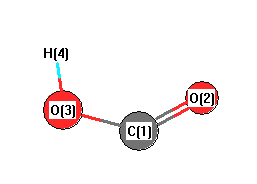Jump to
S1C2
Energy calculated at CISD/daug-cc-pVDZ
| | hartrees |
|---|
| Energy at 0K | -188.622582 |
| Energy at 298.15K | -188.623699 |
| HF Energy | -188.163652 |
| Nuclear repulsion energy | 63.224240 |
The energy at 298.15K was derived from the energy at 0K
and an integrated heat capacity that used the calculated vibrational frequencies.
Vibrational Frequencies calculated at CISD/daug-cc-pVDZ
| Mode Number |
Symmetry |
Frequency
(cm-1) |
Scaled Frequency
(cm-1) |
IR Intensities
(km mol-1) |
Raman Act
(Å4/u) |
Dep P |
Dep U |
|---|
| 1 |
A' |
3809 |
3809 |
55.56 |
|
|
|
| 2 |
A' |
1937 |
1937 |
387.80 |
|
|
|
| 3 |
A' |
1349 |
1349 |
0.13 |
|
|
|
| 4 |
A' |
1126 |
1126 |
208.49 |
|
|
|
| 5 |
A' |
623 |
623 |
35.38 |
|
|
|
| 6 |
A" |
591 |
591 |
119.96 |
|
|
|
Unscaled Zero Point Vibrational Energy (zpe) 4717.5 cm
-1
Scaled (by 1) Zero Point Vibrational Energy (zpe) 4717.5 cm
-1
See section
III.C.1 List or set vibrational scaling factors
to change the scale factors used here.
See section
III.C.2
Calculate a vibrational scaling factor for a given set of molecules
to determine the least squares best scaling factor.
Geometric Data calculated at CISD/daug-cc-pVDZ
Point Group is Cs
Cartesians (Å)
| Atom |
x (Å) |
y (Å) |
z (Å) |
|---|
| C1 |
0.000 |
0.440 |
0.000 |
| O2 |
-1.061 |
-0.362 |
0.000 |
| O3 |
1.156 |
0.192 |
0.000 |
| H4 |
-0.754 |
-1.279 |
0.000 |
Atom - Atom Distances (Å)
| |
C1 |
O2 |
O3 |
H4 |
| C1 | | 1.3304 | 1.1821 | 1.8774 |
O2 | 1.3304 | | 2.2853 | 0.9672 | O3 | 1.1821 | 2.2853 | | 2.4110 | H4 | 1.8774 | 0.9672 | 2.4110 | |
 More geometry information
More geometry information
Calculated Bond Angles
| atom1 |
atom2 |
atom3 |
angle |
|
atom1 |
atom2 |
atom3 |
angle |
| C1 |
O2 |
H4 |
108.568 |
|
O2 |
C1 |
O3 |
130.811 |
Electronic energy levels
Charges, Dipole, Quadrupole and Polarizability
Jump to
S1C1
Energy calculated at CISD/daug-cc-pVDZ
| | hartrees |
|---|
| Energy at 0K | -188.624907 |
| Energy at 298.15K | -188.625997 |
| HF Energy | -188.164488 |
| Nuclear repulsion energy | 63.004761 |
The energy at 298.15K was derived from the energy at 0K
and an integrated heat capacity that used the calculated vibrational frequencies.
Vibrational Frequencies calculated at CISD/daug-cc-pVDZ
| Mode Number |
Symmetry |
Frequency
(cm-1) |
Scaled Frequency
(cm-1) |
IR Intensities
(km mol-1) |
Raman Act
(Å4/u) |
Dep P |
Dep U |
|---|
| 1 |
A' |
3944 |
3944 |
142.12 |
|
|
|
| 2 |
A' |
1977 |
1977 |
289.58 |
|
|
|
| 3 |
A' |
1307 |
1307 |
266.63 |
|
|
|
| 4 |
A' |
1118 |
1118 |
73.10 |
|
|
|
| 5 |
A' |
636 |
636 |
4.64 |
|
|
|
| 6 |
A" |
544 |
544 |
85.90 |
|
|
|
Unscaled Zero Point Vibrational Energy (zpe) 4762.1 cm
-1
Scaled (by 1) Zero Point Vibrational Energy (zpe) 4762.1 cm
-1
See section
III.C.1 List or set vibrational scaling factors
to change the scale factors used here.
See section
III.C.2
Calculate a vibrational scaling factor for a given set of molecules
to determine the least squares best scaling factor.
Geometric Data calculated at CISD/daug-cc-pVDZ
Point Group is Cs
Cartesians (Å)
| Atom |
x (Å) |
y (Å) |
z (Å) |
|---|
| C1 |
0.000 |
0.405 |
0.000 |
| O2 |
-0.943 |
-0.550 |
0.000 |
| O3 |
1.168 |
0.262 |
0.000 |
| H4 |
-1.803 |
-0.126 |
0.000 |
Atom - Atom Distances (Å)
| |
C1 |
O2 |
O3 |
H4 |
| C1 | | 1.3418 | 1.1767 | 1.8798 |
O2 | 1.3418 | | 2.2616 | 0.9595 | O3 | 1.1767 | 2.2616 | | 2.9966 | H4 | 1.8798 | 0.9595 | 2.9966 | |
 More geometry information
More geometry information
Calculated Bond Angles
| atom1 |
atom2 |
atom3 |
angle |
|
atom1 |
atom2 |
atom3 |
angle |
| C1 |
O2 |
H4 |
108.394 |
|
O2 |
C1 |
O3 |
127.668 |
Electronic energy levels
Charges, Dipole, Quadrupole and Polarizability
